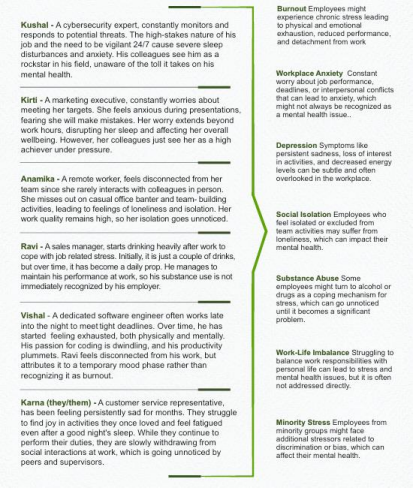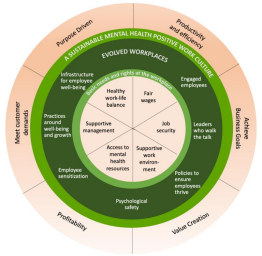India tops the global charts with 59% of employees reporting burnout symptoms. India witnessed a record 64 lakh suicides in 2021, many of which were career-related. Recent tragic events, such as the death of a young EY employee in Pune due to overwhelming work stress, highlight the urgent need to address mental health in Indian workplaces for both employee well-being and business success.
The economic cost of poor mental health is significant. Decreased productivity, increased absenteeism, and higher turnover rates can significantly impact a company’s bottom line. The World Health Organisation estimates that India could lose over $1 trillion due to mental health conditions between 2012 and 2030. To mitigate these losses, Indian businesses must prioritize mental health by implementing regular assessments, counselling services, and stress management programs.
By prioritising mental health, companies can create a more supportive and inclusive work environment. This not only improves employee morale and job satisfaction but also drives long-term economic benefits.
Workplace mental health issues that often go unnoticed:
Most of these situations can be listed under the following common mental health issues being experienced at the workplace:
Note: All names and situations on this page are fictionalised
Recognising these issues early and providing appropriate support can make a big difference. Do any of these resonate with you or your workplace?
Balancing productivity and employee well-being can be challenging but achievable. Creating a supportive work environment makes employees more likely to be engaged and productive. This approach not only benefits employees but also drives better business outcomes.
Using the Doughnut Model
To co-relate this model to mental health in the workplace, we can consider the inner foundational level as the basic needs and rights that must be met for employees, such as fair wages, job security, and a healthy work-life balance
The evidence that excessive work demands and stress can negatively impact mental health must translate to organizations consciously striving for higher levels of mental health maturity.
Here is how it could look:
The inner circle or foundational level showcases the basic needs and rights of employees. Ensuring employees have fair wages, access to mental health resources, supportive management, and a healthy work-life balance. Avoid overwork, and reduce workplace stressors.
The middle circle depicts evolved workplaces. A mental health mature workplace will invest in engaged employees, leaders who walk the talk, policies that ensure employees thrive, and psychological safety and the necessary infrastructure, sensitization and practice to support employee well-being and growth.
The outer circle depicts a sustainable mental health positive culture that balances and is focused on achieving higher levels of maturity in culture and processes. It is also more likely to achieve business goals through higher productivity and continuously create sustained value for customers and stakeholders.
By adopting this framework, organizations can create a workplace that supports mental well-being, prevent burnout and promote a sustainable, profitable and thriving work culture.

Diagram: Adapted from economist Kate Raworth’s Doughnut Model
Organisations can measure the mental health impact on employees through several methods:
By using a combination of these metrics, organizations can gain a comprehensive understanding of the mental health impact on their workforce and take appropriate actions to support their employees. What do you think about these approaches?
We can all contribute towards a healthy mind and a healthy workplace in our work roles and as family and colleagues.
Recognising and addressing mental health issues involves empathy, awareness, and creating a supportive environment. Small mindful actions can have a big impact on someone’s mental well-being.
Role of Leaders
Leaders have the power to drive significant change by implementing supportive policies and fostering a culture of mental well-being. Key actions include:
Role of Managers
Managers play a pivotal role in promoting mental well-being at work. They are often the first point of contact for employees. Here are some practical steps managers can take:
Recognise:
Look for changes in behaviour, such as decreased productivity, absenteeism, irritability, or withdrawal from team interactions.
How to Address:
Role of Colleagues
Recognise: Pay attention to signs like reduced social interaction, increased errors, or frequent expressions of stress or frustration.
How to Address:
Role of Family:
Recognise:
Notice changes in mood, behaviour, and routines. Signs might include withdrawing from family activities, changes in sleep patterns, or expressions of hopelessness.
How to Address:
Despite increased awareness of mental health at work, much remains to be addressed. Currently, the focus is on fixing immediate signs and symptoms. The rise of mental health start-ups and tech offerings to organizations is a positive step, highlighting the need for a supportive workplace environment. However, this approach can act only as a band-aid, failing to address deep-rooted issues costing Indian employers approximately ₹51,000 crores per annum (Data and Statistics of Workplace Mental Health – Deloitte 2024 Report). This is a high price to pay, underscoring the urgent need for organizations to prioritize mental health initiatives to foster a healthier and more productive workforce.
Concerted and mindful efforts are required to realign infrastructure, policies, efficiencies, and productivity. What is the long-term cost of short-term measures? It is like placing speed cameras and ambulances at every corner to manage the consequences, rather than addressing the root causes. Unfortunately, while the concept of slowing down to examine behaviour and culture for long-term success seems inconceivable, it needs consideration simultaneously with short-term measures.
A balanced approach that addresses short-term fixes while working on long-term people, cultural, and profit strategies will have a far better chance of fostering a thriving and healthy workplace. The Maturity Model for sustainable mental health at workplaces, the empathy map for managers, and the realignment of business goals offer a higher chance of ushering in positive change in the workplace.
Did you find this story helpful?
How do you envision AI transforming your work?
By clicking “Subscribe” button above, you are accepting our Terms & Conditions and Privacy Policy.
